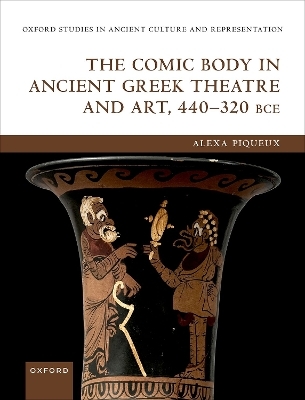
The Comic Body in Ancient Greek Theatre and Art, 440-320 BCE
Seiten
2022
Oxford University Press (Verlag)
978-0-19-284554-2 (ISBN)
Oxford University Press (Verlag)
978-0-19-284554-2 (ISBN)
Through both textual and iconographic sources, this book examines the representations of the body in Greek Old and Middle Comedy, how it was staged, perceived, and imagined, particularly in Athens, Magna Graecia, and Sicily.
Using both textual and iconographic sources, this richly illustrated book examines the representations of the body in Greek Old and Middle Comedy, how it was staged, perceived, and imagined, particularly in Athens, Magna Graecia, and Sicily. The study also aims to refine knowledge of the various connections between Attic comedy and comic vases from South Italy and Sicily (the so-called 'phlyax vases').
After introducing comic texts and comedy-related vase-paintings in the regional contexts, The Comic Body in Ancient Greek Theatre and Art, 440-320 BCE considers the generic features of the comic body, characterized as it is by a specific ugliness and a constant motion. It also explores how costumes —masks, padding, phallus, clothing, accessories— and gestures contribute to the characters' visual identity in relation with speech : it analyzes the cultural, social, aesthetic, and theatrical conventions by which spectators decipher the body. This study thus leads to a re-examination of the modalities of comic mimesis, in particular when addressing sexual codes in cross-dressing scenes which reveal the artifice of the fictional body. It also sheds light on how comic poets make use of the scenic or imaginary representations of the bodies of those who are targets of political, social, or intellectual satire. There is a particular emphasis on body movements, where the book not only deals with body language and the dramatic function of comic gesture, but also with how words confer a kind of poetic and unreal motion to the body.
Using both textual and iconographic sources, this richly illustrated book examines the representations of the body in Greek Old and Middle Comedy, how it was staged, perceived, and imagined, particularly in Athens, Magna Graecia, and Sicily. The study also aims to refine knowledge of the various connections between Attic comedy and comic vases from South Italy and Sicily (the so-called 'phlyax vases').
After introducing comic texts and comedy-related vase-paintings in the regional contexts, The Comic Body in Ancient Greek Theatre and Art, 440-320 BCE considers the generic features of the comic body, characterized as it is by a specific ugliness and a constant motion. It also explores how costumes —masks, padding, phallus, clothing, accessories— and gestures contribute to the characters' visual identity in relation with speech : it analyzes the cultural, social, aesthetic, and theatrical conventions by which spectators decipher the body. This study thus leads to a re-examination of the modalities of comic mimesis, in particular when addressing sexual codes in cross-dressing scenes which reveal the artifice of the fictional body. It also sheds light on how comic poets make use of the scenic or imaginary representations of the bodies of those who are targets of political, social, or intellectual satire. There is a particular emphasis on body movements, where the book not only deals with body language and the dramatic function of comic gesture, but also with how words confer a kind of poetic and unreal motion to the body.
Alexa Piqueux is an Associate Professor of Ancient Greek Literature at Université Paris Nanterre and a Junior Member of the Institut Universitaire de France. Her research revolves mainly around ancient Greek theatre, comic poetry, theatre-related iconography, interrelations between art and text, and the cultural history of Magna Graecia.
Introduction
1: Comedy and Vase-Painting
2: The Construction of the Comic Body: Masks, Phalluses, Padding, and the Comic Ugliness
3: Signs of Genre and Sexual Identity Conveyed by Costume
4: Social and Moral Characterization through Costume
5: The Body in Movement
Conclusion
Appendix: Catalogue of the comedy-related vases mentioned in this study
| Erscheinungsdatum | 25.08.2022 |
|---|---|
| Reihe/Serie | Oxford Studies in Ancient Culture Representation |
| Zusatzinfo | 99 black and white illustrations |
| Verlagsort | Oxford |
| Sprache | englisch |
| Maße | 196 x 252 mm |
| Gewicht | 994 g |
| Themenwelt | Kunst / Musik / Theater ► Kunstgeschichte / Kunststile |
| Kunst / Musik / Theater ► Theater / Ballett | |
| Geisteswissenschaften ► Sprach- / Literaturwissenschaft ► Anglistik / Amerikanistik | |
| Geisteswissenschaften ► Sprach- / Literaturwissenschaft ► Literaturwissenschaft | |
| ISBN-10 | 0-19-284554-3 / 0192845543 |
| ISBN-13 | 978-0-19-284554-2 / 9780192845542 |
| Zustand | Neuware |
| Informationen gemäß Produktsicherheitsverordnung (GPSR) | |
| Haben Sie eine Frage zum Produkt? |
Mehr entdecken
aus dem Bereich
aus dem Bereich
Poetik eines sozialen Urteils
Buch | Hardcover (2023)
De Gruyter (Verlag)
59,95 €
Buch | Softcover (2024)
belleville (Verlag)
20,00 €


